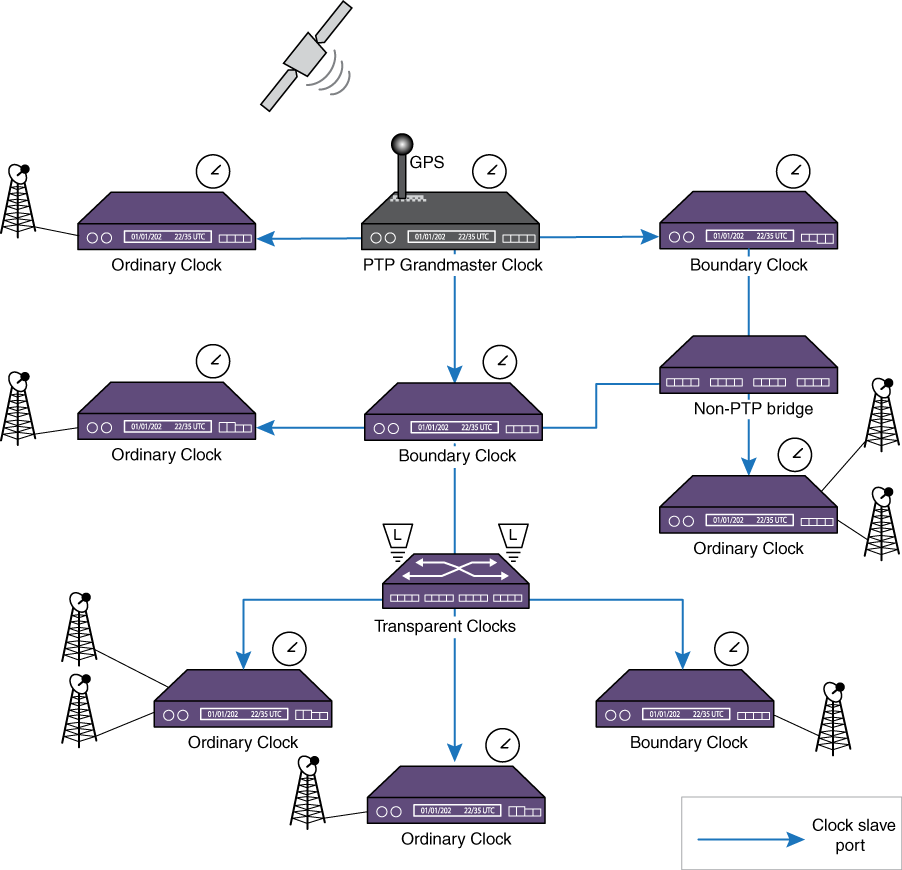Overview of PTP
The IEEE 1588v2 Precision Time Protocol (PTP) defines a packet-based time synchronization method that provides frequency, phase, and time-of-day information with nanoseconds level of accuracy.
PTP relies on the use of carefully time-stamped packets to synchronize one or more slave clocks to a master clock. Synchronous time information is distributed hierarchically, with a grandmaster clock at the root of the hierarchy.
The grandmaster provides the time reference for one or more slave devices. These slave devices can, in turn, act as master devices for further hierarchical layers of slave devices.
To determine the master-slave hierarchy, a Best Master Clock (BMC) algorithm is used. This algorithm determines which clock is the highest quality clock within a network. The clock elected by BMC (the master clock) then synchronizes all other clocks (slave clocks) in the network. If the BMC is removed from the network or is determined by the BMC algorithm to no longer be the highest quality clock, the algorithm then redefines the new BMC and adjusts all other clocks accordingly. No administrator input is needed for this readjustment because the algorithm provides a fault tolerant behavior.
Synchronizing time across a network requires two essential functions: the measurement of delays and the distribution of time information. Each node is responsible for independently determining the delays across the network links from it to its link partners. Once this is accomplished, periodic time synchronization messages may be sent from the grandmaster clock device to the slave clock devices. Link-based delays wander over time, so periodic delay measurements are required. Because these delays vary slowly, the period between link delay measurements is typically in the order of seconds.
A PTP network must have a grandmaster clock reference and a slave. Between a master and a slave, a PTP network may have multiple boundary clocks, transparent clocks, and non-PTP bridges.
PTP Network Hierarchy illustrates a typical PTP network hierarchy.

Ordinary clocks are devices with only one PTP port. The grandmaster clock is an ordinary clock acting as a master.

Note
A PTP port is a logical interface (VLAN / IP interface). A loopback VLAN is added as a clock port to PTP in ExtremeXOS.Boundary clocks are switches with one or more PTP ports. One PTP port of a boundary clock can act as a slave to a master clock in the network, and the rest of the PTP ports can act as a master for the downstream nodes.
Transparent clocks correct the delays for PTP messages in the correction field.
End-to-end transparent clocks accumulate the residence time in the CorrectionField of the PTP messages. End-to-end transparent clocks do not participate directly in time synchronization with the master clock. The CorrectionField of Sync, Delay Request, and Delay Response messages are updated by the end-to-end transparent clocks at each hop. The Signaling and Management messages are not updated by transparent clocks. In a typical setting, boundary and slave clocks are separated by one or more end-to-end transparent clocks that accumulates the residence time in the CorrectionField.
The residence time is defined as the delay between the reception and the transmission of packets through the device. The accumulated CorrectionField value is used by boundary or slave clocks for delay compensation in the time offset correction.

